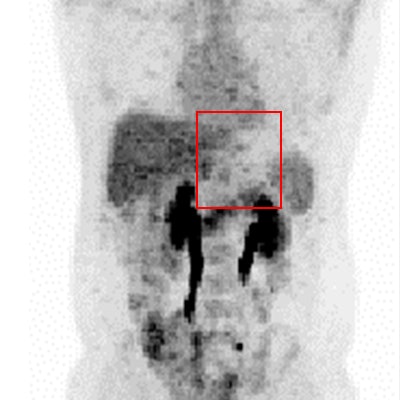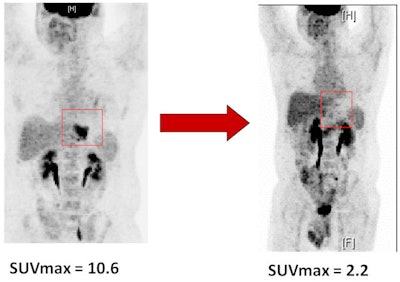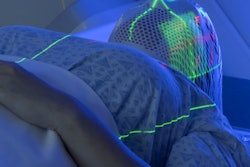
By using PET scans to assess the efficacy of chemotherapy for esophageal cancer early in the course of treatment, clinicians can change their treatment strategy if necessary and greatly improve patient outcomes, according to a presentation at the American Society of Clinical Oncology (ASCO) annual meeting in Chicago.
The findings come from a multicenter trial that identified patients who did or did not respond to induction chemotherapy. By using PET to determine which patients did not fare well after six weeks of treatment, clinicians were able to switch to a different regimen during chemoradiation and extend median overall survival by nine months.
"We showed that we have biomarkers that can help us identify patients who are responding to our regimens and use that information to tailor our therapy more appropriately," said lead author Dr. Karyn Goodman, chair of clinical oncology at the University of Colorado Cancer Center. "The hope is that we can improve outcomes for all our patients."
Multicenter study
The Cancer and Leukemia Group B trial, CALGB 80303, began about 10 years ago to investigate the efficacy of standard esophageal cancer treatment, which typically combines preoperative chemotherapy with radiation followed by surgery. This regimen is geared toward patients with resectable stage II/III esophageal and gastroesophageal cancer.
"The problem is that our outcomes are still quite poor, even with an aggressive management of chemotherapy, radiation, and surgery," Goodman told AuntMinnie.com. "One of the issues is that we do not know the optimal chemotherapy regimen. So we wanted to find a better way to tailor therapy for patients."
The current study follows a presentation by Goodman and colleagues at last year's ASCO meeting that showed that changing the chemotherapy regimen for nonresponders increased the rate of pathologic complete response. The result was no trace of cancer in tissue specimens taken at the time of surgery.
Multiple prior studies have used different treatment regimens, but not every patient responds well to chemotherapy. One of the primary risks of treatment failure is the spread of the disease, Goodman added.
"Typically, 15% to 20% of patients have a complete pathological response to chemoradiation," she said. "In patients who have been treated and were thought to be PET nonresponders in a previous study, the complete pathological response was only 5%. Our goal was to improve the complete pathological response rate from 5% to 20% in our nonresponders who would respond to the alternative chemotherapy."
Chemo treatments
For their study, Goodman and colleagues enrolled 257 patients with adenocarcinoma of the esophagus or gastroesophagus. PET scans were performed at the time of diagnosis and after six weeks of induction chemotherapy. Patients were randomized into one group that received folinic acid, fluorouracil, and oxaliplatin, known as FOLFOX, or a second group that received carboplatin and Taxol.
"If the tumor had responded to chemotherapy and that particular regimen, we continued the chemotherapy with radiation together, and then the patient went to surgery," Goodman said.
The researchers measured response via changes in maximum standardized uptake values (SUVmax) on PET, characterizing it as a drop of 35% from baseline. This was based on previous studies from Germany that established the 35% mark as a predictive cutoff for favorable outcomes for patients with esophageal cancer receiving chemotherapy.
The primary end point of the study was complete pathologic response, with the absence of any residual cancer cells in the surgical specimen.
"So patients with a less than 35% decrease in SUVmax were thought to be nonresponders and they were switched to alternative chemotherapy during radiation," Goodman explained.
Survival times
In reviewing the baseline and follow-up PET scans, the researchers found that overall median survival time was longer for patients who responded to induction chemotherapy (46 months) than for those who did not respond (27 months).
"This makes sense," Goodman added. "Again, these are patients who benefited from induction chemotherapy, whether with FOLFOX or with carboplatin-Taxol. We would expect them to live longer than patients who did not respond."
 PET scans before and after chemotherapy from a patient who responded to treatment. There is increased FDG uptake in the lower esophagus before chemotherapy (red box in left image) and minimal FDG uptake after chemotherapy (red box in right image).
PET scans before and after chemotherapy from a patient who responded to treatment. There is increased FDG uptake in the lower esophagus before chemotherapy (red box in left image) and minimal FDG uptake after chemotherapy (red box in right image).However, the median survival time of 27 months for those who switched regimens was longer than the 18-month median survival time cited in previous studies in which the same treatment was used with no change.
"Twenty-seven months median overall survival is much better than we have seen in previous studies for patients who do not respond to induction chemotherapy," Goodman said. "We show that using PET scans at baseline and then again after induction chemotherapy can help to determine who should stick with the chemotherapy used during induction and who should switch to the other regimen during chemoradiation."
In addition, patients who responded to induction chemotherapy with FOLFOX and stayed with that treatment during chemoradiation achieved a four-year survival rate of 55%, the best-ever outcome reported for patients with this disease, according to the researchers.
Chemo side effects
The median age of the subjects in the study was 65 years. It's a patient population that is likely to have other comorbidities, so this aggressive treatment plan of chemotherapy, radiation, and surgery for esophageal cancer can be "quite debilitating," Goodman said.
In terms of side effects, the subjects generally tolerated the treatments well, she added, with toxicity not exceeding levels that are normally expected.
"One of the other things we wanted to establish was the use of induction chemotherapy to test responsiveness and whether we might add additional toxicity to the overall treatment," she said. "One of the outcomes that we will look at ultimately is the impact on postoperative complications."
As for applying the findings to cancer treatment in the clinical setting, patients at the University of Colorado Cancer Center now routinely receive initial induction chemotherapy. The clinicians begin with FOLFOX because the complete pathological response rate is in the range of 38%, Goodman said.




















